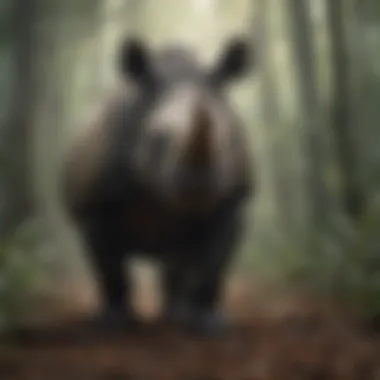Current Status of Sumatran Rhinoceros Populations


Intro
The Sumatran rhinoceros (Dicerorhinus sumatraensis) has long been a key figure within the ecosystems of Southeast Asia. Yet, the current status of its population poses a stark commentary on human impact on biodiversity. Recent studies reveal a critical decline in their numbers, primarily due to factors like habitat loss and poaching. In this article, we examine the complexities surrounding the Sumatran rhinoceros and the desperate circumstances that threaten its future.
> "The Sumatran rhinoceros is not just an endangered species; it is a living testament to the fragility of ecological balance."
This overview provides insights into the recent research findings, conservation efforts, and vital statistics surrounding the fate of this species. A deeper understanding of these elements can illuminate the road ahead and the strategies necessary for survival.
Research Overview
Methodological Approaches
Research on the Sumatran rhino employs diverse methods ranging from field surveys to genetic studies. These approaches often include:
- Field Monitoring: Direct observation and data collection in natural habitats to assess population size and structure.
- Camera Traps: Innovative technology used to capture images of these elusive animals. This helps in estimating their presence in various areas.
- Genetic Analysis: Understanding genetic diversity is crucial for breeding programs. Biologists analyze DNA samples to assess relationships among populations.
Each method contributes vital information that exploits distinct angles of research. Gathering data is crucial to ascertain the most affected regions and specific threats faced by these animals.
Significance and Implications
The implications of the research findings extend beyond academic understanding. Conservation strategies hinge upon accurate data, which if misinterpreted, can lead to misallocation of resources. Accurate insights into population dynamics guide interventions. Protection measures derived from research can significantly enhance survival odds for the Sumatran rhinoceros.
Current Trends in Science
Innovative Techniques and Tools
Recent advancements in technology have opened new avenues for rhino conservation. Notable techniques include:
- Drone Surveys: Drones are used to survey vast areas, capturing data on habitat conditions and potential threats like illegal encroachment.
- Remote Sensing: Satellite imagery assists in monitoring habitat loss over time, making it easier to identify and act against emerging threats.
These tools enhance the efficiency of research initiatives, allowing for real-time updates on the conditions faced by the Sumatran rhino.
Interdisciplinary Connections
Conservation of the Sumatran rhinoceros encompasses various fields such as ecology, sociology, and economics. Understanding local communities’ roles in conservation efforts is vital, as they are essential stakeholders. Integrative approaches allow scientists to draw from sociology and anthropology, promoting local stewardship over rhinos.
This connection underscores the necessity for multifaceted strategies. When communities see the benefits of a healthy ecosystem, such as ecotourism, they are more likely to become active participants in conservation efforts.
Prolusion
The Sumatran rhinoceros is facing an alarming decline in population. Understanding its current status is vital for conservation efforts. This article aims to present an analytical overview focused on the significance of this species within its ecosystem.
Population dynamics play a crucial role in biodiversity. The Sumatran rhinoceros holds a unique place as one of the last remaining species of rhinos. Establishing the current population status helps in identifying gaps in conservation strategies. Furthermore, analyzing the threats it faces aids in formulating effective policies and actions to secure its future.
The urgent need to address the challenges posed by habitat loss and poaching cannot be overstated. Compounding these issues is the fragmentation of remaining populations, which further threatens genetic diversity. Hence, an understanding of these elements provides a solid foundation for appreciating the multifaceted nature of wildlife preservation.
Noting these aspects allows for an informed discussion on conservation efforts and strategies. This discourse intends to ignite interest and awareness about the declining state of the Sumatran rhinoceros. A well-informed public is crucial for advocating action toward protecting this endangered species.
Understanding the Sumatran Rhinoceros


The Sumatran rhinoceros, known scientifically as Dicerorhinus sumatraensis, is a distinct species classified as critically endangered. Unlike its larger relatives, the Asian and African rhinos, the Sumatran rhinoceros is smaller and more elusive, making its study challenging. They typically inhabit dense rainforests, often seeking shelter in areas that provide both cover and food.
This species is unique not just in size but also in its genetic makeup, exhibiting characteristics that are vital to ecological health. They play a role in seed dispersal, which is crucial for the survival of various plant species.
Efforts to track their numbers have shown troubling trends over the years. With less than 80 individuals estimated to remain in the wild, initiatives to monitor and protect these animals are more crucial than ever. Their habitat is increasingly under threat, which exacerbates the difficulty in maintaining a stable population.
Additionally, Sumatran rhinos face intense pressure from illegal poaching driven by high demand in traditional medicine, particularly in some Asian regions. These factors highlight the complexity and urgency of the situation, necessitating immediate attention and intervention from both local and global stakeholders.
Estimation of Current Population
Understanding the current population of the Sumatran rhinoceros is crucial for researchers, conservationists, and policymakers. It not only highlights the urgency of the species' plight but also provides a baseline for measuring the effectiveness of conservation efforts. Accurate population estimates help in allocating resources efficiently and in strategizing appropriate intervention measures. Furthermore, understanding population dynamics helps in identifying genetic diversity, which is essential for the long-term survival of the species.
Latest Population Estimates
Recent estimates suggest that the population of the Sumatran rhinoceros stands as low as 80 to 100 individuals, primarily distributed across isolated locations in Indonesia and Malaysia. The existing population is fragmented, with groups residing in Bukit Barisan Selatan National Park in Sumatra and in Borneo. This isolation increases the risk of inbreeding and decreases the chances of successful reproduction.
Due to the ephemeral nature of wildlife monitoring in dense forest habitats, obtaining precise numbers is challenging. Techniques such as camera traps, fecal DNA analysis, and direct observation have improved the accuracy of these estimates. Ongoing research stresses the importance of data collection and continuous monitoring to track these numbers effectively.
"The survival of the Sumatran rhinoceros rests on our commitment to understanding their population dynamics and protecting their habitats."
Geographical Distribution
The geographical distribution of the Sumatran rhinoceros is predominantly confined to the islands of Sumatra and Borneo. Historically, their range extended much further across Southeast Asia. Currently, however, they are exclusively found in several isolated pockets. These areas include Bukit Barisan Selatan National Park, Way Kambas National Park, and the Indonesian Borneo region.
Distribution is influenced by various factors, including habitat suitability, food availability, and human encroachment. The Sumatran rhinoceros prefers tropical rainforests and dense underbrush for cover and foraging. With continuous deforestation and the establishment of agricultural land, many rhinoceros habitats are at risk. Thus, protecting these areas is vital in ensuring their survival and reducing the impact of human activities on their distribution.
Factors Contributing to Decline
The Sumatran rhinoceros is under significant threat, with several key factors contributing to its declining population. Understanding these elements is essential for devising effective conservation strategies. Each factor does not operate in isolation; they intertwine, reinforcing the challenges faced by this species. Addressing these issues holistically is vital for ensuring the survival of the Sumatran rhinoceros.
Habitat Loss
One of the most pressing issues affecting the Sumatran rhinoceros is habitat loss. The destruction of forests due to agricultural expansion, logging, and infrastructure development has severely impacted their living spaces. The Sumatran rainforest is being transformed at an alarming rate. As this happens, the rhinoceros is left with fewer areas to thrive.
The conversion of land for palm oil plantations is a major driver of deforestation. In some regions, the remaining patches of forest are fragmented, making it difficult for rhinoceroses to find mates and maintain healthy populations. This loss not only diminishes their habitat but also affects their access to food and water resources, essential for their survival.
Poaching Trends
Poaching is another critical factor contributing to the decline of the Sumatran rhinoceros. Despite laws protecting these animals, illegal hunting continues. The demand for rhinoceros horn, believed to hold medicinal properties in some cultures, fuels this poaching crisis. Organized crime syndicates often target rhinos, making it difficult for local authorities to control this issue.
According to various reports, the poaching rate has not diminished significantly in recent years. The risk of poaching is magnified by the low numbers of Sumatran rhinoceroses, which makes each individual lost to poachers all the more significant. The tragic reality is that even if anti-poaching initiatives are strengthened, the existing demand for rhino horns remains a substantial incentive for poachers.
Fragmentation of Populations
Population fragmentation is a by-product of habitat loss and poses another significant threat. As the natural habitats of the Sumatran rhinoceros become segmented, isolated populations form. This isolation can lead to inbreeding, reducing genetic diversity. Inbreeding makes rhinos more vulnerable to diseases and decreases their ability to adapt to environmental changes.
Furthermore, fragmented populations face increased risks from human-wildlife conflicts. As rhinoceroses wander into agricultural areas in search of food, they often come into contact with humans. This interaction can lead to retaliatory killings from farmers or increased human encroachment into rhinoceros habitats, exacerbating the cycle of decline.
In summary, the combination of habitat loss, poaching, and population fragmentation creates a challenging landscape for the Sumatran rhinoceros. Each factor compounds the others, making the need for targeted conservation efforts urgent. Without a coordinated approach that addresses each of these elements, the future of this species remains bleak.


Conservation Efforts
The urgency of conservation efforts for the Sumatran rhinoceros cannot be overstated, as these initiatives form the backbone of hopes for the species' survival. With current population estimates suggesting that fewer than 80 individuals remain, the need for effective actions becomes paramount. These efforts encompass various strategies aimed at habitat protection, community engagement, and international collaboration. Each element serves not only to safeguard existing populations but also to enhance the ecological integrity of their habitats.
Protected Areas and Sanctuaries
Protected areas and sanctuaries play a critical role in the conservation of the Sumatran rhinoceros. These regions offer safe havens where the rhinos can thrive without the pressures of habitat destruction or poaching. Notable sanctuaries like the Way Kambas National Park in Sumatra provide necessary space for breeding and natural behaviors.
The establishment of such areas ensures:
- Habitat protection: By restricting human activities that could negatively impact the ecosystem, animals have a chance to live and breed in a healthier environment.
- Monitoring and research opportunities: Protected areas allow scientists and conservationists to monitor rhino populations closely. This data is invaluable for effective management strategies.
- Awareness building: These sanctuaries often serve as educational platforms for visitors, raising awareness about the plight of the Sumatran rhinoceros.
Community Involvement in Conservation
Community involvement is fundamental for the long-term success of conservation efforts. Local populations can provide crucial support in protecting these animals. Engaging with communities fosters a sense of ownership over local wildlife. This translates into active participation in conservation practices.
Key aspects include:
- Education programs: Informing locals about the importance of the Sumatran rhinoceros and the role they can play in its survival.
- Economic incentives: Promoting eco-tourism can generate income while simultaneously creating a vested interest in wildlife conservation.
- Conflict resolution: Establishing strategies to mitigate human-wildlife conflict ensures communities can coexist with the Sumatran rhinoceros.
International Partnerships
Global cooperation is essential to bolster conservation efforts for the Sumatran rhinoceros. Partnerships between countries, NGOs, and various stakeholders facilitate the sharing of resources, knowledge, and best practices. Collaborative projects can lead to funding opportunities and enhanced research capabilities.
Benefits of international partnerships include:
- Shared expertise: Different entities can pool their knowledge, leading to more effective conservation strategies.
- Cross-border initiatives: Wildlife does not recognize borders. Joint efforts can help secure migration corridors essential to the Sumatran rhinoceros' survival.
- Influence policy changes: International advocacy can lead to stricter global regulations on wildlife trade and poaching.
The future of the Sumatran rhinoceros hinges on effective conservation efforts, community involvement, and strong international collaboration.
It is evident that without these concerted actions, the odds of survival for the Sumatran rhinoceros diminish significantly. Understanding and implementing these conservation efforts is critical for species preservation.
Scientific Research and Monitoring
Scientific research and monitoring play a crucial role in understanding the current status of the Sumatran rhinoceros population. Accurate data is essential for effective conservation strategies. Research helps identify population size, dynamics, and distribution, which are key components for implementing measures to protect this endangered species. Monitoring programs ensure ongoing assessment of their habitats and threats, offering insights that can guide policy decisions and on-ground efforts.
Tracking Population Dynamics
Tracking population dynamics involves studying the changes in the Sumatran rhinoceros population over time. This includes birth rates, mortality rates, and the movement of individuals across geographic regions. Methods such as camera trapping and genetic analysis are often used to gather data.
Data from these studies reveal that populations are declining, with estimates suggesting fewer than 80 individuals remain in the wild today. Understanding the causes of these changes is vital. Factors like poaching and habitat fragmentation can considerably affect these rates. By tracking population dynamics, conservationists can adapt their strategies and respond to changing conditions more effectively.
Technological Innovations in Conservation
Technological innovations are transforming conservation efforts for the Sumatran rhinoceros. Tools such as satellite telemetry and drones are providing new ways to monitor rhino movements and their habitats. For instance, satellite collars allow researchers to track movements in real-time, which is invaluable for assessing habitat use and identifying potential poaching threats. Furthermore, drone technology can survey vast areas quickly, helping to locate individuals and monitor habitat conditions from an aerial perspective.
These innovations also enhance community engagement in conservation. Local communities can be trained to use technology for monitoring efforts, creating a sense of ownership over the protection of their wildlife. This collaborative approach not only increases the effectiveness of conservation strategies but also helps build awareness and support for sustainable practices.
Analysis of Critical Threats


Climate Change Impacts
Climate change remains a significant and growing challenge for the Sumatran rhinoceros. The shifts in weather patterns, rising temperatures, and increased frequency of extreme weather events alter their natural habitat. The rhinoceros relies on dense tropical forests, which are sensitive to climate fluctuations. Changes in rainfall patterns can affect the availability of food and water sources critical for survival. Furthermore, increased temperatures can lead to forest degradation, further threatening rhinoceros populations.
Research shows that rising sea levels can also encroach upon lowland habitats where these animals reside. The loss of suitable habitat drives the rhinoceros populations into less favorable areas, potentially leading to increased stress and competition for resources. Moreover, it may create new obstacles for breeding and migration.
Human-Wildlife Conflict
Human-wildlife conflict represents a grave threat to the Sumatran rhinoceros. As human populations expand into rhinoceros habitats, interactions between people and wildlife become more frequent. The primary reason behind these conflicts is competition for land and resources.
Farmers often see rhinoceroses as pests that damage crops, leading to retaliatory actions. This situation creates a cycle of harm, where both humans and wildlife suffer. In addition, the encroachment of agriculture and urban development into rhinoceros territories results in habitat fragmentation. This fragmentation limits the mobility of rhinoceroses, preventing them from finding food, mates, and safe environments.
"The persistent expansion of human activities into natural habitats poses a continuous threat to the survival of endangered species like the Sumatran rhinoceros."
To counteract this issue, awareness and educational programs for local communities are essential. Engaging with communities to develop sustainable agricultural practices can help mitigate conflicts. Understanding the importance of preserving these majestic animals is critical for both ecological balance and the future of biodiversity.
Identifying and addressing the threats posed by climate change and human-wildlife conflicts is essential for the conservation of the Sumatran rhinoceros. Acknowledging these aspects not only aids in safeguarding this species but also enriches the broader conversation on biodiversity and ecosystem preservation.
Future Outlook for the Sumatran Rhinoceros
The future outlook for the Sumatran rhinoceros must be considered through multiple lenses. These lenses include population trends, conservation goals, and the interplay of ecological and socio-economic factors impacting survival. Understanding this outlook is essential to formulating effective strategies, ensuring the Sumatran rhinoceros does not join the ranks of other extinct species.
Forecasting Population Trends
Forecasting population trends for the Sumatran rhinoceros involves analyzing data collected from various regions. Numerous studies indicate a grim trajectory. Current estimates suggest fewer than 80 individuals exist primarily in fragmented populations across Indonesia. This fragmentation poses significant hurdles for gene flow and overall population resilience.
Recent methodologies in data collection include camera traps and genetic surveys. These innovative approaches enable researchers to assess not only the number of individuals but also their health and genetic diversity. For instance, if the population remains isolated, inbreeding becomes a serious concern, leading to lower reproductive success and increased vulnerability to disease. As a result, predictive modeling using this data shows that, without considerable conservation interventions, population numbers could decline further over the next decades.
"The continuity of the Sumatran rhinoceros hinges on timely and informed interventions, addressing the multitude of factors at play."
Long-Term Conservation Goals
Long-term conservation goals focus on stabilizing and ideally increasing Sumatran rhinoceros populations. Success hinges on multiple coordinated efforts that include creating additional protected areas, enforcing anti-poaching laws, and gaining local community support through education and sustainable livelihood programs.
Key elements of these goals comprise:
- Habitat Restoration: Rehabilitating areas that have been degraded due to logging or agriculture to ensure enough space and resources for the rhinoceros.
- Translocation: Relocating individuals from strong populations to those critically low in numbers, fostering genetic diversity and encouraging growth in isolated groups.
- Community Engagement: Empowering local populations can greatly enhance conservation outcomes. Educating communities about the ecological role of the rhinoceros promotes active participation in its protection.
Ending
The conclusion section serves as a crucial element of this article, encapsulating the key insights regarding the current status of Sumatran rhinoceros populations. It acts as a synthesis of the previous discussions, allowing readers to grasp the gravity of the situation faced by this endangered species. The Sumatran rhinoceros, with its dwindling numbers, stands as an emblem of biodiversity at risk.
Recapitulating Key Findings
In the sections analyzed earlier, several vital points emerge:
- The current population of the Sumatran rhinoceros is critically low, with estimates suggesting fewer than 80 individuals remain in the wild. This dramatic decline is primarily due to human activities.
- Habitat loss is a significant threat. Deforestation for agriculture and urban development has fragmented their living spaces, diminishing their natural habitats.
- Poaching remains an ongoing crisis. Despite international efforts, illegal hunting for rhino horns persists, driven by demand for traditional medicine and as a display of wealth in certain cultures.
- Conservation strategies must be multifaceted, incorporating both on-the-ground efforts and broader policy reforms. Protecting existing sanctuaries is pivotal for the survival of the species.
Call to Action for Conservation
To mitigate the impending extinction of the Sumatran rhinoceros, a proactive approach is required. The following actions are critical:
- Awareness Campaigns: Raising public awareness about the plight of the Sumatran rhinoceros can foster community support for conservation initiatives.
- Strengthening Legislation: Governments must enhance laws against poaching and illegal trade, ensuring stricter penalties for offenders.
- Collaboration: International cooperation between governments, NGOs, and research institutions is vital for sharing data and resources.
- Community Engagement: Involving local communities in conservation efforts can empower them and encourage sustainable practices that protect habitats.
The future of the Sumatran rhinoceros relies on immediate and concerted efforts from all stakeholders. The potential for recovery exists, but only if there is a genuine commitment to reversing current trends.



